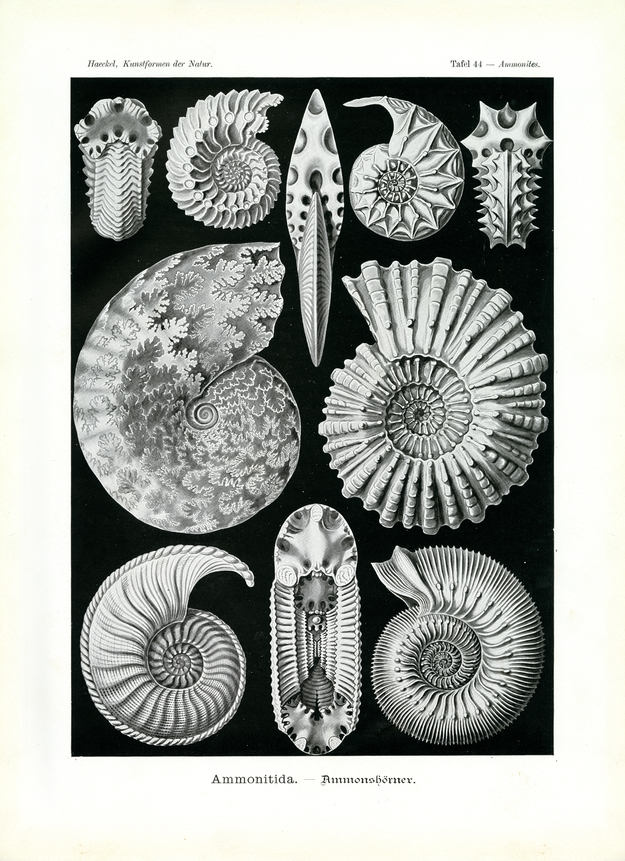Translation of the original German introduction by Ernst Haeckel:
Phylum of Mollusca (Weichtiere); - subclass of Cephalopoda (Kraken or Tintenfische); - family of Ammonitida or Ammonoidea (Ammonshörner).
The highly variable family of Ammonitida presents a very interesting group of Cephalopoda, most highly organized Mollusca, extinct long ago. Thousands of species of Mollusca lived during the Paleozoic and especially during the Mesozoic times and became completely extinct towards the end of Cretaceous period. Their beautifully shaped lime shells, petrified, have accumulated in such vast quantities that rock mass is predominantly composed by it, for example in the Jura Mountains; individual mountain layers can be characterized with the help of particular forms of Ammonitida. The Mollusk that formed multi-chambered cases and inhabited the last (youngest) chamber of the case is completely unknown to us as far as its organization is concerned; what can be claimed safely is that it was a genuine Cephalopoda, just like Nautilus, Octopus and Sepia. Whether Ammonitida, however, were most closely related to Nautilus and thus belonged to the ‘four-gilled’ (Tetrabranchia) or rather, like Spirula, Sepia and Octopus, to the ‘two-gilled’ (Dibranchia), cannot be decided on the basis of shell formation alone. The lime shell of Ammonitida is planospiral, symmetrically furled on one level, consisting of a huge number of chambers that are separated by solid diaphragms. The chambers were filled with air as it is the case with the ‘four-branchial’ Nautilus and the ‘two-branchial’ Spirula, both alive today; they formed a virtuous hydrostatic apparatus that reduced the specific weight of the body, thus facilitating swimming, like the air bladder of fishes. The living animal inhabited the youngest and biggest, lastly formed chamber, fixed inside with the help of a firm strand (Sipho) that pierced the diaphragm. The diaphragms (Septa) of the air chambers (in fig. 2, 4, 6 and 8, seen from the front) are bent more or less wave-like so that their attachment to the exterior wall of the shell is not ensued in a simple ring line but in delicately curved ‘Sutur-lines’ or ‘Loben-lines’ with branched-off projections as lobes and saddles (fig. 5). Furthermore, the exterior surface of the shell is usually ornamented with radial ribs, fillets, ledges, quills, etc.
Translation by VR Translators Bangalore
We've scanned the original lithography at 1200dpi on the Epson A3 scanner of A3 scanner huren. You can download a 400dpi JPEG here.
